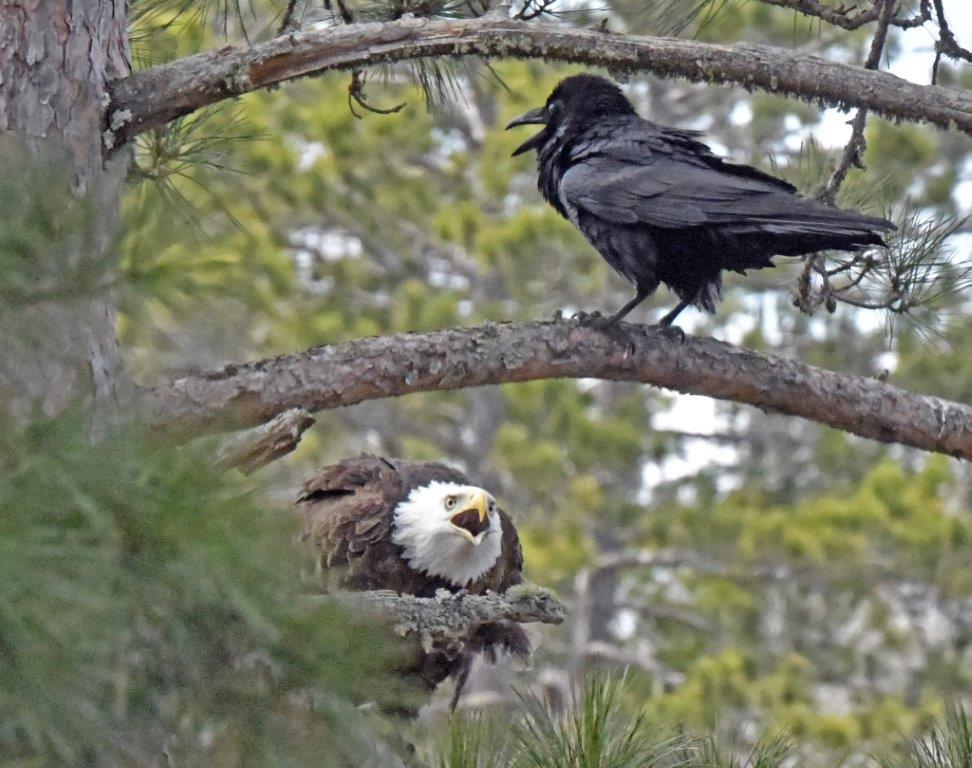Daily Updates
Savage Competition - UPDATE May 10, 2020
10 May 2020
Print Email
A couple days ago, I put a pile of beef fat out in the yard. Gulls were already here and were the first to take advantage. Crow flying off with fat
Crow flying off with fat

Crows discovered it and darted in grabbing small pieces and flew off with them. Crows weigh about a pound and can probably carry about a third of a their weight in their beak if they are comparable to gray jays. Birds that can transfer weights to the feet (closer to the center of lift) instead of carrying it in the beak can carry twice as much as they can carry in their bill, as I wrote in a 2005 paper Turkey Vulture swooping in
Turkey vulture swooping in
 https://www.bearstudy.org/website/images/stories/Publications/Rogers_2005_Weight-carrying_capacity_and_caching_behavior_of_Gray_Jays.pdf
https://www.bearstudy.org/website/images/stories/Publications/Rogers_2005_Weight-carrying_capacity_and_caching_behavior_of_Gray_Jays.pdf. Pretty soon, the small pieces were gone. The remaining pieces were bigger than a gull can swallow or a crow could carry off. More competition was soon to arrive?turkey vultures. Four of them swooped in with their 6-foot wingspans and big feet and little heads, weighing about 4 pounds (all weights according to Sibley Birds [2014]). These vultures are strong enough to pull big pieces of fat apart to swallow. All was peaceful. The turkey vultures had each gotten their pieces of fat with little strife and were pulling them apart. More competition arrived?ravens. Turkey vulture and raven tug of war
Turkey vulture and raven tug of war

The ravens were cautious at first. A pair up in a tree seemed relaxed, nicely touching their bills together as mates.
Then the ravens, which weigh only about 2.6 pounds, went into action. They are little more than half the weight of a turkey vulture but have bigger heads and bills. Turkey vultures have small, narrow heads with no feathers; which I?m guessing is so they can poke their heads into small openings into the abdomens of carrion to eat internal organs. I?m guessing that because the common belief about polar bears having narrow heads and long necks is so they can dive into seal air holes in the ice to catch them.Raven attacking turkey vulture over fat
Raven attacking turkey vulture over fat

A turkey vulture was pulling a piece of fat apart when a raven approached. The raven watched from a foot or two away for several seconds and then dove in and got its beak on the fat and was in for a tug-of-war. The vulture valiantly kept a toe over the fat to gain an advantage, but then the fat pulled apart and each had a share.
Raven attacking turkey vulture
Raven attacking turkey vulture

Elsewhere, another raven approached a turkey vulture, paused, and attacked; going for the turkey vulture?s head as the vulture kept a foot on the fat but turning its head away from the raven?s bigger bill. The raven suddenly then was in front of the vulture again going for the vulture?s head. The vulture always turned away to avoid the raven?s bill and never did anything aggressive with its bill. It finally took its foot off the fat, turned, and retreated. The raven got the fat?the whole piece.
Eagle defending against mob
Eagle defending against mob

But competition wasn?t over. Three eagles arrived, each weighing over three times as much as a raven. The ravens left the fat to mob the eagles. Both of the eagles flew in and landed in trees. An adult eagle sat quietly but warily in a big red pine, looking at a raven on a branch when another dove from out of sight and hit the back of the eagle. The eagle then hopped from branch to branch, futilely chasing the ravens with its beak open. The ravens just hopped tauntingly away while others mobbed the eagle. The ravens had strength in numbers and seemed to work as a team. All three eagles flew off. The ravens had no real competition as they finished off the fat, being the efficient scavengers they are. Quiet returned.
I had never seen anything like that before.
Thank you for all you do.
Lynn Rogers, Biologist, Wildlife Research Institute and North American Bear Center

 Author
Topic: Jewel and her cubs (Read 2270130 times)
Author
Topic: Jewel and her cubs (Read 2270130 times)
